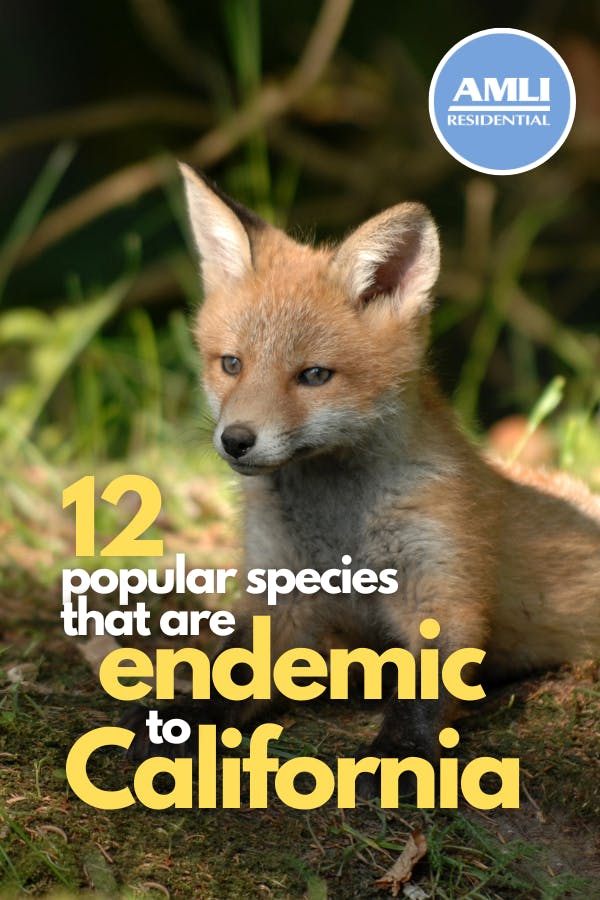California is a big and beautiful state, with 5 major climate zones and ten climate subdivisions spread over mountains, valleys, deserts and seashores.
Here are just a few recognizable species endemic to California, with more than a few endemic to certain islands of the Channel Islands, too!
12 animals and plants endemic to California
Giant sequoia
Sequoiadendron giganteum
The giant sequoia is a coniferous tree that can grow up to 300 feet tall and 36 feet in diameter. It has reddish-brown bark that is up to 2 feet thick, with awl-shaped leaves about half an inch long. True giant sequoias are found in a small area of the Sierra Nevada mountains in California, with many living trees known to have been standing there for up to 3,500 years!
California condor
Gymnogyps californianus
The California condor is a large bird of prey with a wingspan of up to a whopping 9.5 feet — making it the largest land bird on the continent. It has a black body with a white neck ruff and a bald neck and head, and it can be found nesting, hunting and gliding in the mountains and foothills of California.
Santa Cruz Island fox
Urocyon littoralis
The Channel Islands fox is a small fox that is found on the Channel Islands off the coast of Southern California. It has a reddish-brown coat with a white belly. This sweet-looking but ferocious fox is an omnivore and eats a variety of plants and animals on the hills and coasts around the Channel Islands National Park.
Santa Cruz long-toed salamander
Batrachoseps luciae
Found in the Santa Cruz Mountains of California and sporting a dark brown or black body with light brown or yellow spots, the Santa Cruz long-toed salamander spends most of its amphibious life in moist areas under rocks and logs where it can eat bugs and goo to its heart’s content.
Smith's blue butterfly
Plebejus idas shasta
This small, delicate butterfly is light blue with a delicate black lace edge on its wings and can often be seen flitting around wildflowers in the California mountains. Count yourself lucky if you see one, though, because the species is endangered and threatened by habitat loss.
Coast horned lizard
Phrynosoma coronatum
With a brown body, black spots and a row of pointed spines down its back, the Coast horned lizard eats a variety of insects and plants in the dry and rocky areas of the Laguna Mountains in Southern California and Mexico.
Sierra Nevada bighorn sheep
Ovis canadensis sierrae
The Sierra Nevada bighorn sheep grazes on a variety of grasses shrubs, and leaves as it roams the rocky mountains of the Sierra Nevada. Though you’re not likely to run into too many horned sheep on your hike, you can identify this one by the large, brown horns that spiral around their ears.
San Joaquin kit fox
Vulpes macrotis mutica
With large, pointed ears, grayish-orange fur and a pointed nose, this sweet little fox can only be found in the San Joaquin Valley where it hunts small rodents and birds. Unfortunately, this species has been endangered since 1967, when urban and industrial development began to eat away at its natural habitat.
Desert tortoise
Gopherus agassizii
You may see this gentle desert creature lumbering through the Mojave Desert as it searches for cactus and grasses to munch on. You can recognize it by its brownish-yellow shell with black markings, so keep an eye out for it on the roads!
Devil’s Hole pupfish
Cyprinodon salinus
Yup! Death Valley has an endemic species of fish!
The Devil’s Hole pupfish is a tiny, goldfish-like fish that can only be found in the Devil’s Hole Oasis, an extensive warm-water system that creates almost unlivable conditions that the fish have adjusted to. If you have the chance to see them at all, then count yourself lucky — they are an endangered species and their population is declining.
Point Reyes mountain beaver
Aplodontia rufa phaea
You’re a lucky one if you ever get a chance to glimpse this solitary seashore creature, as the only place you can see it is on the Point Reyes National Seashore.
The species — or, rather, the species’ lineage — is believed to have lived in the region for 50 million years, making it one of the oldest rodent types in the continent!
Island spotted skunk
Spilogale gracilis amphixanthus
This hard-to-spot (get it? Spot? Hah! ) solitary skunk emerges after dark on the Channel Islands off the Los Angeles Coast, when it slinks through the night on the hunt for rodents, vegetables and insects. Other than the Channel Island fox, it’s the only land carnivore found on the islands!
If you live anywhere in or near our luxury Southern California apartments, then keep an eye out for these species next time you’re visiting a state park or a national park near Los Angeles. You’ll not get another chance to see these creatures anywhere else in the world!
Enjoy!
Pin it!

Featured photo courtesy Pixabay/imranhussain1343431


 View All Posts by Colleen Ford
View All Posts by Colleen Ford